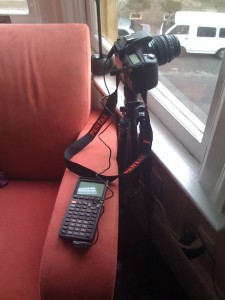Time-Lapse Photography with a TI-85 Graphing Calculator
Filed Under Gadgets & Hardware, Hacks and Mods on 2008-10-31, 13:55
I’ve got a soft spot for time-lapse stuff. Most of the time I make my own videos using a webcam because I have things all set up so that it’s easy and quick for me. However, because the webcam is such low quality, I’ve always had a desire to do some higher resolution time-lapse. With my DSLR (a Pentax K100D), I knew that I would be able to take much better quality photos, but the problem was that it didn’t have a handy way for taking a photo at set intervals. Sure, I could have bought an intervalometer, but that costs money and would be another gadget to add to my collection. Then I came across this instructables: Turn a TI Graphing Calculator into an Intervalometer. All you needed was a TI Calculator, the old Calc-to-Calc link cable (which had a 2.5mm plug) and a DSLR that would accept a 2.5mm remtoe trigger shutter. I had all three.
I dug through my old boxes, pulled out my old TI-85 Calculator and dusted it off. By “dusted it off” I mean I cleaned off the battery corrosion that had built up over the years. Some fresh batteries, and a moment of silence for all the games and programs I wrote in high school that had died with the batteries, and I was ready to program my own intervalometer. If you can’t find your old calculator, you can search for a TI calculator on eBay. Make sure it’s one with a link cable (which you can also find cheap on eBay).
It took a few minutes for me to remember how the TI-85 worked, but before long I was writing my first program in probably 10 years. The Instructables suggested the following code for a TI-83 calculator:
: Prompt A
: While 1
: For (H,1,A,1)
: End
: Send(A)
: End
This caused a problem, as the TI-85 calculator doesn’t have the integral Send() function needed to send a signal along the link cable. A little bit of research, and I discovered that you needed to use Outpt(“CBLSEND”,A) instead of Send(A) for the TI-85 calculator. Note, for TI-85 owners, you’ll need at least v9.0 or higher ROM for this. You can check your version by hitting [2nd] [MODE] [ALPHA] [S] and then [EXIT]. I also added an extra line that displays “SNAP!” when a photo should be taken to help troubleshoot if things aren’t working. You can get even fancier with this program, but this is the basic version that should work.

I plugged the calculator into the camera with the link cable, and fired up the program. The first few times I tried really low numbers. Entering 100 for A should give you about a second between shots. While I was testing I had it in RAW mode and it just wasn’t capable of shooting that quickly. I finally settled on entering 5000, which gives me about 12 seconds in between shots, resulting in about 5 shots a minute. I also switched from RAW mode to JPG, since I don’t want to deal with converting all those RAW files into JPGs later. I also set everything (focus, aperture, exposure) to manual so that they wouldn’t change in between shots. I also turned of the photo preview so the LCD wasn’t wasting batteries showing the picture it just took. Then I put the camera on a tripod, pointed it out the window and started the program. After some time I finally stopped the program (hold down the ON key to break execution) and downloaded the images to my laptop for compiling in Quicktime and ended up with what you see above! I can’t wait to try this on a nicer day though, as dreary San Francisco fall days aren’t very exciting.
I should note that the newer Pentax K20D actually has a built in intervolameter, but it’s not clear whether this will produce good time-lapse results as there are some limits on it. Anyone played around with it?
Some good links:
Instructables article
All you ever wanted to know about the TI-85 Calculator
TI Calc FAQ (circa 1997)
Tagged: camera, dslr, TI-85 Calculator, time-lapse, Video